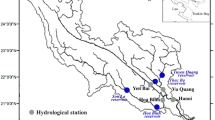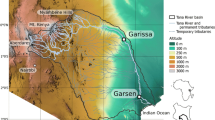Abstract
There are 10,091 km2 of peatlands in Estonia and human activities may have changed the role of northern peatlands from global sinks to global sources of carbon. The aim of this work was to explain the changes in organic carbon exports from eleven Estonian rivers in the period 1992–2007 in terms of land use change, climate change quantified by trends in stream-water discharge and hydrological droughts and reductions in atmospheric sulfate quantified by change in water chemistry. Direct TOC (total organic carbon) measurements had been initiated in 1998. We used CODKMnO4 (permanganate oxygen consumed) as its surrogate for the whole time span (Spearman’s determination coefficient in six small northern Estonian rivers 0.95 > ρ2 > 0.72; p < 0.01). The Mann–Kendall test revealed significant trends in the TOC proxy in five small rivers in northern Estonia (M–K stat > 2.35; p < 0.05). The trends in the eleven investigated streams correlated closely with the increased 28 ratios of drought days (Spearman’s ρ2 = 0.68; p < 0.01). The correlations with land use compositions, decreases in water discharges and SO4 2− concentrations were insignificant (p > 0.05). We conclude that the main factor in the increase of organic carbon export is the deepening of droughts driven by climate change, magnified by man-made drainage.




Similar content being viewed by others
References
Adermann V (2008) Eesti metsad. Centre of Forest Protection and Silviculture
Allikvee H, Ilomets M (1995) Sood ja nende areng. In: Raukas A (ed) Estonia: Nature. Valgus, Estonian Encyclopaedia Publishers, Tallinn
Blodau C, Basiliko N, Moore TR (2004) Carbon turnover in peatland mesocosms exposed to different water table levels. Biogeochemistry 67:331–351
Cheng G et al (2005) Research of the correlation between TOC and COD in water. Environ Monitor China 21(5)
Driscoll CT, Cirmo CP, Fahey TJ, Blette VL, Bukaveckas PA, Burns DA, Gubala CP, Leopold DJ, Newton RM, Raynal DJ, Schofielf CL, Yavitt JB, Porcella DB (1996) The experimental watershed liming study: comparison of lake and watershed neutralization strategies. Biogeochemistry 32:143–174
Eriksson H (1991) Sources and sinks of carbon dioxide in Sweden. Ambio 20:146–150
Evans CD, Monteith DT, Cooper DM (2005) Long-term increases in surface water dissolved organic carbon: Observations, possible causes and environmental impacts. Environ Pollut 137:55–71
Evans CD, Chapman PJ, Clark JM, Monteith DT, Cresser MS (2006) Alternative explanations for rising dissolved organic carbon export from organic soils. Glob Change Biol 12:2044–2053
Findlay SEG (2005) Increased carbon transport in the Hudson River: unexpected consequence of nitrogen deposition? Front Ecol Environ 3:133–137
Freeman C, Ostle N, Kang H (2001) An enzymic ‘latch’ on a global carbon store. Nature 409:149
Freeman C, Fenner N, Ostle NJ, Kang H, Dowrick DJ, Reynolds B, Lock MA, Sleep D, Hughes S, Hudson J (2004) Export of dissolved organic carbon from peatlands under elevated carbon dioxide levels. Nature 430:195–198
Frey J, Linder M, Frey T (2009) Õhusaaste ja ilmastiku mõju Saare järve sissevoolu pinnaveele 1995–2008. Publicationes Instituti Geographici Universitatis Tartuensis 108:225–239
Gilliom RJ, Helsel DR (1986) Estimation of distributional parameters for censored trace level water quality data 1. Estimation techniques. Water Resour Res 22:135–146
Gorham E (1991) Northern peatlands, role in the carbon cycle and probable responses to climate warming. Ecol Appl 1:182–195
Haei M, Oquist MG, Buffam I, Öquist MG, Buffam I, Ågren A, Blomkvist P, Bishop K, Löfvenius MO, Laudon H (2010) Cold winter soils enhance dissolved organic carbon concentrations in soil and stream water. Geophys Res Lett 37:L08501
Hisdal H, Holmqvist E, Hyvärinen V, Jónsson P, Kuusisto E, Larsen S, Lindström G, Ovesen NB, Roald L (2003) Long time series—a review of nordic studies. CWE Long Time Series group, Reykjavik
Hruška J, Krám P, McDowell WH, Oulehle F (2009) Increased dissolved organic carbon (DOC) in Central European streams is driven by reductions in ionic strength rather than climate change or decreasing acidity. Environ Sci Technol 43:4320–4326
Iital A, Pachel K, Loigu E, Pihlak M, Leisk Ü (2010) Recent trends in nutrient concentrations in Estonian rivers as a response to large-scale changes in land-use intensity and life-styles. J Environ Monitor 12:178–188
Ilomets M, Kallas R (1995) Estonian mires—past, present and future alternatives. Gunneria 70:117–126
Järvekülg A (2001) Estonian rivers. University Press, Tartu
Järvet A (2004) Influence of hydrological factors and human impact on the ecological state of shallow Lake Võrtsjärv in Estonia. Dissertation, University of Tartu
Kopáček J, Procházková L, Stuchlík E, Blažka P (1995) The nitrogen-phosphorus relationship in mountain lakes: influence of atmospheric input, watershed, and pH. Limnol Oceanogr 40:930–937
Kothawala DN, Evans RD, Dillon PJ (2006) Changes in the molecular weight distribution of dissolved organic carbon within a Precambrian shield stream. Water Resour Res 42:W05401
Lehner B, Döll P (2001) Europe’s droughts today and in the future. In: Lehner B, Hendrichs T, Döll P, Alcamo J (eds) EuroWasser—model-based assessment of European water resources and hydrology in the face of global change. Center for Environmental Systems Research, Kassel
Lepistö A, Kortelainen P, Mattsson T (2008) Increased organic C and N leaching in a northern boreal river basin in Finland. Glob Biogeochem Cycles 22:GB3029
Libiseller C, Grimvall A (2002) Performance of partial Mann Kendall tests for trend detection in the presence of covariates. Environmetrics 13:71–84
Mander Ü, Kull A, Tamm V, Kuusemets V, Karjus R (1998) Impact of climatic fluctuations and land use change on runoff and nutrient losses in rural landscapes. Landsc Urban Plan 41:229–238
Mattsson T, Kortelainen P, Lepistö A, Räike A (2007) Organic and minerogenic acidity in Finnish rivers in relation to land use and deposition. Sci Tot Environ 383:183–192
Monteith DT, Stoddard JL, Evans CD, de Wit HA, Forsius M, Høgåsen T, Wilander A, Skjelkvåle BL, Jeffries DS, Vuorenmaa J, Keller B, Kopácek J, Vesely J (2007) Dissolved organic carbon trends resulting from changes in atmospheric deposition chemistry. Nature 450:537–540
Oechel WC, Hastings SJ, Vourlitis G, Jenkins M, Riechers G, Grulke N (1993) Recent change of arctic tundra ecosystems from a carbon sink to a source. Nature 361:520–523
Pastor J, Solin J, Bridgham SD, Updegraff K, Harth C, Weishampel P, Dewey B (2003) Global warming and the export of dissolved organic carbon from boreal peatlands. Oikos 100:380–386
Perelman AI (1975) Geokhimiya landshafta, 2nd edn. Vysshaya shkola, Moscow
Roulet N, Moore TR (2006) Browning the waters—comment. Nature 444:283–284
Schindler DW, Curtis PJ, Bayley SE, Parker BR, Beaty KG, Stainton MP (1997) Climate-induced changes in the dissolved organic carbon budgets of boreal lakes. Biogeochemistry 36:9–28
Tamm T, Nõges T, Järvet T, Bouraoui F (2008) Contributions of DOC from surface and groundflow into Lake Võrtsjärv (Estonia). Hydrobiologia 599:213–220
Tammets T (2007) Distribution of extreme wet and dry days in Estonia in last 50 years. Proc Eston Acad Sci Eng 13:252–259
Tipping E, Woof C, Rigg E, Ineson P, Taylor K, Benham D, Poskitt J, Rowland AP, Bol P, Harkness DD (1999) Climatic influences on the leaching of dissolved organic matter from upland UK moorland soils, investigated by a field manipulation experiment. Environ Int 25:83–95
Toming K, Arst H, Paavel B, Laas A, Nõges T (2009) Spatial and temporal variations in coloured dissolved organic matter in large and shallow Estonian waterbodies. Boreal Environ Res 14:959–970
Treier K, Pajuste K, Frey J (2004) Recent trends in chemical composition of bulk precipitation at Estonian monitoring stations 1994–2001. Atmos Environ 38:7009–7019
von Brömssen C (2004) The partial Mann-Kendall test for detection of trend in the presence of covariates. Department of Economics, Swedish University of Agricultural Science. Last Accessed 1 July 2010
Vuorenmaa J, Forsius M, Mannio J (2006) Increasing trends of total organic carbon concentrations in small forest lakes in Finland from 1987 to 2003. Sci Tot Envir 365:47–65
Worrall F, Burt T (2005) Predicting the future DOC flux from upland peat catchments. J Hydrol 300:126–139
Yallop AR, Clutterbuck B (2009) Land management as a factor controlling dissolved organic carbon release from upland peat soils 1: spatial variation in DOC productivity. Sci Tot Envir 407:3803–3813
Acknowledgments
This study was supported by Estonian Science Foundation grant No. 7527 and Target Funding Project SF0180127s08 of the Estonian Ministry of Education and Research. We sincerely thank Ms. Ülle Leisk from the Department of Environmental Engineering of Tallinn University of Technology and Ms. Valeria Galushkina from EMHI for their data and comments.
Author information
Authors and Affiliations
Corresponding author
Rights and permissions
About this article
Cite this article
Pärn, J., Mander, Ü. Increased organic carbon concentrations in Estonian rivers in the period 1992–2007 as affected by deepening droughts. Biogeochemistry 108, 351–358 (2012). https://doi.org/10.1007/s10533-011-9604-0
Received:
Accepted:
Published:
Issue Date:
DOI: https://doi.org/10.1007/s10533-011-9604-0




